Here are my experiments of David's miche that is absolutely delicious and became my most favorite hard bread. I, who was not a big fan of sour flavor in the bread look for sourer taste in this miche now. I think because of my raisin yeast water doesn't get so sour like acetic acid, it is more like malic acid when I retard it.
David's miche here: http://www.thefreshloaf.com/node/21644/miche-hit
How I made these miche:
No 1. 4/19( Started at 8 AM) to 4/21:
- Step1 Mixed 26g KA AP/3g raisin yeast water +23g water → fermented for 10 hours at 76F.
- Step2 Mixed the step1/94g KA AP/94g water → Refrigerated(42.8F) as soon as I mixed them and fermented for 24 hours until doubled.
- Final dough: 586g KA bread flour/398g water/18g toasted wheat germ/15g salt
Method:
- Autolyzed for 40 minutes
- Added salt and knead until passed a window pane
- Bulk fermentation 10 hours ( S&F 2 times interval 45 minutes)
- Shape→ Proof in a refrigerator( 42.8F) for 12 hours
- Next morning: Proof at 72-74 F for 1 hours 45 minutes-
- Bake I used the 2 pans like Dutch oven method.

baked 20 minutes at 450F with steam, took the 2 pans and transfer the bread in the rack on the baking stone to bake more 40 minutes at 420F.


It was little bit sour ( fruity) in 12 hours , but I did taste sour ( fruity) in 24 hours. It was a shocking moment to taste this wonderful bread. After we ate all this bread,I wanted to make more of this bread.
-------------------------------------------------------------
Then I did!
No.2 4/22( Start at 8:15am)-4/24:
- Step1 : Mixed 22g raisin yeast water/ 22g KA AP--- That was a mistake. I was about to make 26g KA AP/ 26g raisin yeast water.--Fermented it for 6 hours at 76F until doubled. I should have waited until tripled.
- Step2 Mixed the step1/94g KA AP/94g water- refrigerated as soon as I mixed them and fermented for 88 hours (4/26 6:12 AM) until doubled. I had to wait for long hours...
- Final dough: 586g KA bread flour/398g water/18g toasted wheat germ/15g salt.
Method:
- Autolyzed for 40 minutes
- Added salt and knead until passed a window pane.
- Bulk fermentation 11 hours ( S&F Once after 45 minutes)
- Shape
- Proof in a refrigerator for 12 hours ( I put the shaped dough in a back pack and then kept in the refrigerator (50F) after I stored the dough in the refrigerator (42.8F) for several hours)
- Bake 20 minutes at 446F with steam, took the 2 pans and transfer the bread in the rack on the baking stone to bake more 40 minutes at 400F.
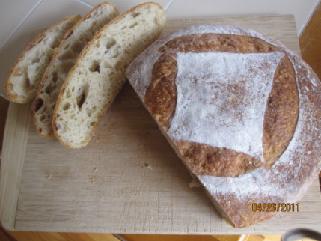

The taste was sweeter. When I tasted it in 12 hours, I didn't taste any sour from the raisins. 24 hours later, I tasted fruity sourness slightly. I rather sourer for this bread. I baked at lower temperature to get brown crust, but I found out that I liked darker crust for this miche.
---------------------------------------------------------------------------------------------------------------------
No.3 and No. 4
5/2 (Started at 7pm)-5/7: I made 2 miche: One (R)- Retarded , the other one (NR)--not retarded.
1. Step1 Mixed 26g KA AP/26g raisin yeast water x2 ---
(R) Fermented it in the refrigerator for 59 hours( 5/5 6 am) until doubled.
( NR) Fermented it at room temperature ( 68-70F) for 12 hours until tripled.
2. Step2 mixed the step1/71g KA AP, 23g KA whole wheat/94g water x2
(R) Fermented it in the refrigerator for 47 hours until doubled.
(NR)Fermented it for 4 hours at room temperature (70F) until tripled
3. Final dough: 586g KA bread flour/398g water/18g toasted wheat germ/15g salt
No.3 (NR)
- Autolyzed for 40 minutes
- Added salt and knead until passed a window pane
- Bulk fermentation 11.5 hours at 68F ( S&F 1 time after 45 minutes)
- Shape
- Proof for 1 hour at 68F
- Continute to proof for 3 hours at 60F
- Bake 12 minutes at 465F with steam, took the top pan and bake 8 more minutes at 465F, took the bottom pan and trasfered the bread on the camp stove toaster and continute to bake more 40 minutes.
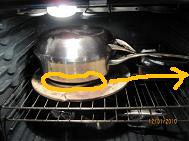
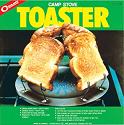
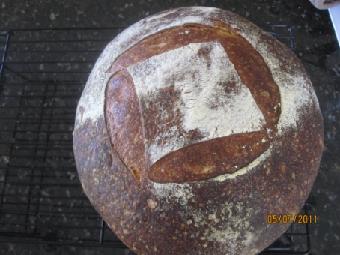

24 hours later, The taste was sour ( fruity) slightly. I also tasted more flavor from the whole wheat that I put in the 2nd levain. The crumb was not as moist as the others that I retarded, however it was delicious.
No.4 (R)
- Autolyzed for 40 minutes
- Added salt and knead until passed a window pane
- Bulk fermentation 10 hours at 70F ( S&F 1 time after 45 minutes)
- Shape
- Proof for 1 hours at76F
- Retarded (42.8F) for 6 hours, decreased the temperature to (50F) and continue to retard for 7hours.
- Bake 12 minutes at 465F with steam, took the top pan and bake 8 more minutes at 465F, took the bottom pan and trasfered the bread on the camp stove toaster and continute to bake more 40 minutes.


I didn't degas much before I shaped. 24 hours later, I tasted sour ( fruity) like the first one. but I tasted more flavor from the whole wheat that I put it in the 2nd levain.
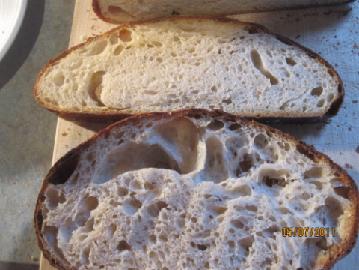 The top (NR) : The bottom (R)
The top (NR) : The bottom (R)
I liked (R) more than (NR). Retarding over night gives the crumb moist very well.
---------------------------------------------------------------------------------------------------
No.5(5/12-5/14)
1. Step1 Mixed 26g KA AP/10g raisin yeast water +16g water for 12 hours.
2. Step2 mixed the step1/71g KA AP, 23g KA whole wheat/50g water+44g raisin yeast water.
Fermented it at room temperature for 4 hours at 70F , decrease the temperature to 68F and fermented it more 6 hours .
( Yes, it became really sour ( acetic) !)
3. Final dough: 586g KA bread flour/ 190g raisin yeast water +208g water /18g toasted wheat germ/15g salt I added 2 tbsp homemade rum syrup that I have kept alcoholic raisins which in my raisin yeast water with sugar. I hoped that this yeasts which I used more raisin yeast water in the final dough and the rum syrup overcome the acetic bacteria...

Method:
- Autolyzed for 40 minutes
- Added salt and knead until passed a window pane
- Bulk fermentation 6 hours at 68F ( S&F 1 time after 45 minutes) until doubled
- Shape
- Proof for 6 hour at 68F
- Bake 12 minutes at 465F with steam, took the top pan and bake 8 more minutes at 465F, took the bottom pan and trasfered the bread on the camp stove toaster and continute to bake more 40 minutes.
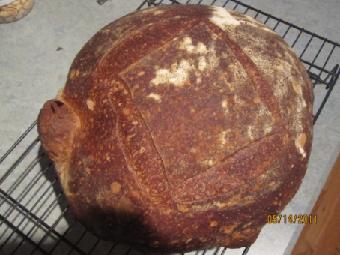
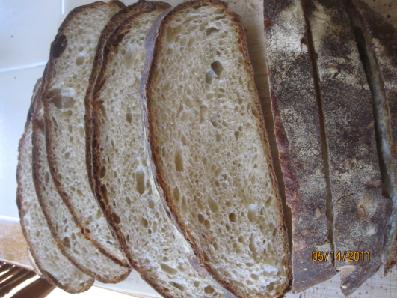


It turned out pretty good. I only tasted fruity sourness ( sweet and sour) which was stronger than others above. but it was really good bread.
----------------------------------------------------------------------------------------------------
No.6 ( 5/11-5/15)
1. Step1 Mixed 26g KA AP/10g raisin yeast water +16g water for 11 hours until 2.5 tims in bulk.
2. Step2 mixed the step1/71g KA AP, 23g KA whole wheat/25g water+ 42g raisin yeast water.
Fermented it in the refrigerator for 12 hours until doubled.
3. Final dough: 586g KA bread flour/398g water/18g toasted wheat germ/15g salt .
Method:
- Autolyzed for 40 minutes
- Added salt and knead until passed a window pane
- Bulk fermentation 9 hours at 68F ( S&F 1 time after 45 minutes) until doubled
- Shape
- Proof for 1 hour at 72F.
- Retarded (42.8F) it for 11 hours.
- Bake 12 minutes at 465F with steam, took the top pan and bake 8 more minutes at 465F, took the bottom pan and trasfered the bread on the camp stove toaster and continute to bake more 40 minutes.
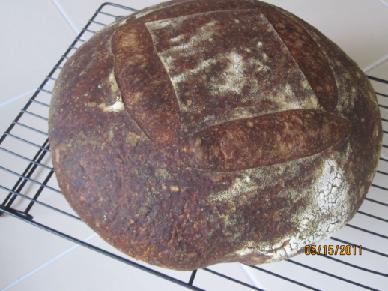


24 hours later, The taste was very cloese to the one that I baked in 5/14. But I like this better because the crumb had more moist.
I still continue to play with this bread. :)
Thank you for sharing your wonderful miche, David!! Thank you so much!
I also thank you everbody to read such a long story.
Best wishes,
Akiko
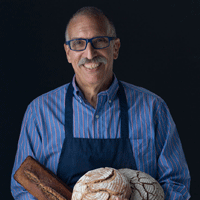



















 The top (NR) : The bottom (R)
The top (NR) : The bottom (R)

















